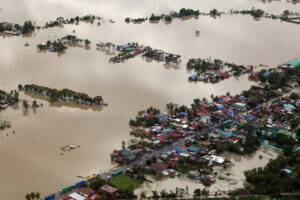By Vonn Andrei E. Villamiel
THE PHILIPPINES dropped 12 spots to 19th in the 2026 Climate Change Performance Index (CCPI) as weak renewable energy expansion and soft climate policies offset its strong record on greenhouse gas emissions and energy use.
The annual index, published by Germanwatch, NewClimate Institute, and Climate Action Network, ranks the climate mitigation performances of 63 countries and the European Union, which collectively account for 90% of global greenhouse gas emissions. The index looks at the progress in emissions, renewables, energy use, and climate policies.
The Philippines, which ranked 7th in the previous edition, slipped to a “medium” performance rating, overtaken by countries that advanced more rapidly in deploying clean energy and firming up climate policies. Despite the drop, the Philippines outperformed its peers in Southeast Asia with an overall score of 62.78, highest in the region.
The top three spots in the ranking remain empty as the authors noted that “no country is doing enough to prevent dangerous climate change.” Denmark again received the top ranking at fourth place, followed by the UK, Morocco, Chile and Luxembourg. Fossil fuel suppliers Saudi Arabia, Iran, the US and Russia were at the bottom of the table.
While the Philippines is often cited as a vocal advocate for climate-vulnerable nations, the CCPI gave the country a weak grade on national climate policy and a medium rating in international climate policy.
Jose Enrique A. Africa, executive director at think tank IBON Foundation, told BusinessWorld via Viber that while the Philippines is vocal about vulnerability, adaptation, and climate justice, there is “really not much real action to see.”
“The CCPI’s international-policy score presumably also assesses how the government translates international talk into domestic practice — and the Philippines isn’t really showing large-scale and consistent domestic reforms nor, actually, correspondingly credible international engagements,” Mr. Africa said.
He added that a major portion of the Philippines’ climate-mitigation budget under the Marcos administration is being poured into “corruption-ridden flood control projects.”
Climate advocacy organization Aksyon Klima Pilipinas (AKP) recently reported that the Philippines’ climate strategy is infrastructure-heavy, with the majority of its climate-mitigation budget over the past five years going to flood control and drainage projects.
“More public funds should go towards environmental protection and conservation, and genuine climate action, especially nature-based solutions. They are more cost-effective and even have co-benefits,” AKP National Coordinator John Leo Algo, who also contributed to the CCPI’s climate policy evaluation, said in a briefing last week.
According to the CCPI, only five of the 63 countries assessed earned a “high” overall rating for climate policy, while 41 countries received “low” or “very low” scores.
“Despite some visible achievements, current climate targets and their implementation are still not at a sufficient pace to keep global warming below 1.5°C. Most countries now have climate policies in place, though their effectiveness varies,” the report said.
Renewable energy also remains a major weak spot for the Philippines. According to the Department of Energy (DoE), renewables accounted for about 26% of the energy mix in 2023, with the government targeting a 35% share by 2030, based on the Philippine Energy Plan for 2023 to 2050.
While renewable energy capacity has increased in recent years, the index shows that the overall share of renewables in the Philippines is still low. The country’s 2030 targets also fall short of levels that will allow it to hit the Paris Agreement goal of limiting the rise in global temperatures to well below 2°C, preferably 1.5°C, above pre-industrial levels.
Meanwhile, the Philippines continues to perform well in terms of greenhouse gas emissions, with the index reporting relatively low per-capita levels.
The Philippines also scored well on energy use, with lower per-capita consumption than more industrialized economies. The report also found that the Philippines’ energy use trends and targets are in line with the pathways that will limit warming to well below 2°C.
Mr. Africa said the Philippines seems to do well in emissions and energy-use metrics “simply because of our economic backwardness.”
“Measured by GDP per capita, the country is still among the poorest one-third globally with correspondingly moderate per-capita emissions,“ he said.
To improve its climate change performance, Mr. Africa said the Philippines should scale up public investment in the green transition, especially in renewable energy, grid modernization, and energy storage.
“There has to be a stronger push to phase out fossil-fuel infrastructure with strengthened regulatory agencies resistant to corporate capture. Decentralized renewable generation, micro-grids, and community energy systems in remote islands to reduce vulnerability and accelerate deployment are long overdue,” Mr. Africa said.
He added that climate policy must be integrated with social development by linking climate action to labor policy, social protection, inclusive rural electrification, equitable energy access, and retraining displaced workers who depended on fossil fuel-heavy jobs.
The 30th United Nations Climate Change Conference (COP30) is entering its second week in Belém, Brazil, where countries are negotiating stronger climate action and mobilizing climate finance for vulnerable nations.
The Philippines, consistently ranked among the world’s most climate-vulnerable countries, hosts the board of the Fund for Responding to Loss and Damage, a newly established financing mechanism that provides grants to developing nations to address the impact of climate-related disasters.
